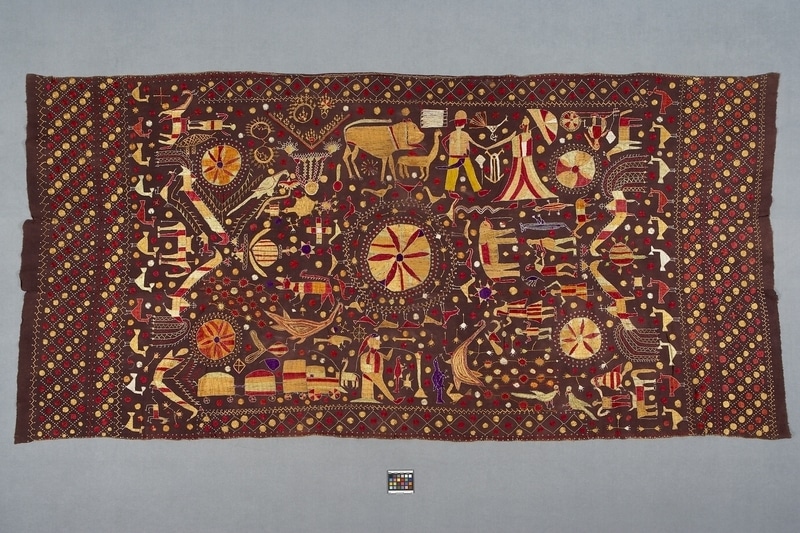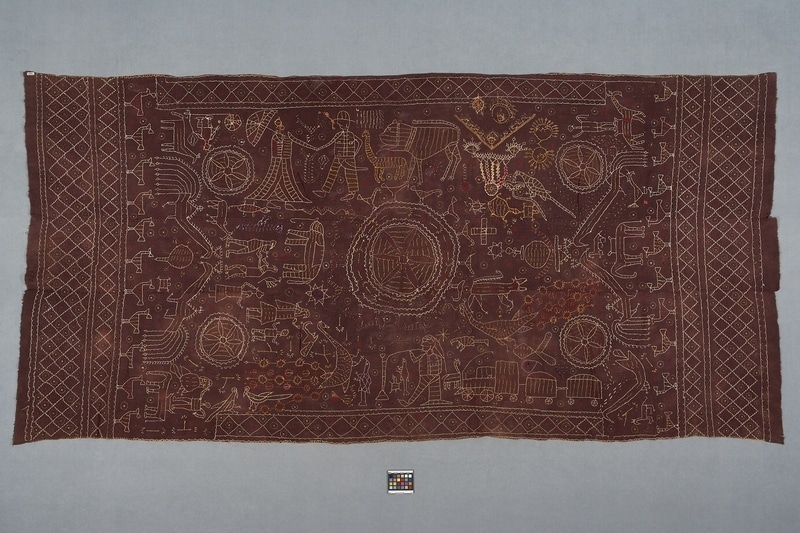Shawl Item Number: Ef406 from the MOA: University of British Columbia


Description
A long rectangular cotton cloth (khaddar) of three hand sewn long panels with the sides unfinished along the top and bottom. Blanket stitched and embroidered in three sections with silk threads. Mid-section has central circular motif surrounded by four borders of squares, zigzags, flowers, and birds. Circular motif is a lotus. Repeated on each corner, there are nine humans of varying sizes performing activities such as a couple getting married, smoking, playing games, dancing and walking. There are many scattered peacocks, parrots, and other animals. Also, a train, engine, and three coaches in the lower left corner, and pieces of shringar patti (head jewelry) in the upper left corner. Top and bottom are bordered with three rows of circles enclosed in diamonds. Two end sections are almost mirror images. Bordered with six rows of circles in diamonds and a row of eleven peacocks surmounted by two large peacocks. There is a different animal at each corner. Two humans on one end with one on the other standing atop a steed. Colours include red, orange, dark yellow, yellow, indigo, and white on a brown background.
History Of Use
Traditionally an important part of bride's trousseau. Worn by women; also used as bedspread, curtain, or wall hanging.
Iconographic Meaning
Lotus signifies universal life force and the opening up of consciousness for the divine. Peacock symbolizes beauty and immortality.
Item History
- Made in Punjab, India between 1840 and 1870
- Collected during 1979
- Owned by Sotheby Parke Bernet Ltd. before August 22, 1979
- Received from Sotheby Parke Bernet Ltd. (Seller) and Fyfe-Smith Memorial Oriental Collection Fund (Funding source) on August 22, 1979
What
- Name
- Shawl
- Identification Number
- Ef406
- Type of Item
- shawl
- Material
- cotton fibre, silk fibre and dye
- Manufacturing Technique
- woven, dyed, cut, sewn and embroidered
- Overall
- height 258.0 cm, width 126.0 cm
Who
- Culture
- Punjabi
- Previous Owner
- Sotheby Parke Bernet Ltd.
- Received from
- Sotheby Parke Bernet Ltd. (Seller) and Fyfe-Smith Memorial Oriental Collection Fund (Funding source)
Where
- Holding Institution
- MOA: University of British Columbia
- Made in
- Punjab, India
When
- Creation Date
- between 1840 and 1870
- Collection Date
- during 1979
- Ownership Date
- before August 22, 1979
- Acquisition Date
- on August 22, 1979
Other
- Item Classes
- textiles
- Condition
- good
- Accession Number
- 0547/0001